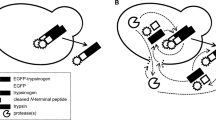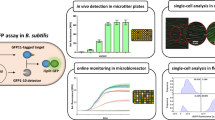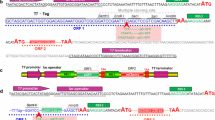Abstract
The use of Pichia pastoris for protein production was simplified by creation of fusion proteins containing green fluorescent protein (GFP) and the product of interest. Human interleukin-2 (hIL-2) was used as a model product: GFP enabled clear identification of fusion protein expression and, more importantly, the quantification of hIL-2. Although GFP fusions for bioprocess monitoring have been demonstrated in other hosts, this is its first use in P. pastoris.
Similar content being viewed by others
References
Albano CR, Randers-Eichhorn L, Bentley WE, Rao G (1998) Green fluorescent protein as a real time quantitative reporter of heterologous protein production. Biotechnol. Prog. 14: 351–354.
Cha HJ, Dalal NG, Pham MQ, Vakharia VN, Rao G, Bentley WE (1999a) Insect larval expression process is optimized by generating fusions with green fluorescent protein. Biotechnol. Bioeng. 65: 316–324.
Cha HJ, Dalal NG, Vakharia VN, Bentley WE (1999b) Expression and purification of human interleukin-2 simplified as a fusion with green fluorescent protein in suspended Sf-9 insect cells. J. Biotechnol. 69: 9–17.
Cha HJ, Pham MQ, Rao G, Bentley WE (1997) Expression of green fluorescent protein in insect larvae and its application for foreign protein production. Biotechnol. Bioeng. 56: 239–247.
Cha HJ, Wu CF, Valdes JJ, Rao G, Bentley WE (2000) Observations of green fluorescent protein as a fusion partner in genetically engineered Escherichia coli: monitoring protein expression and solubility. Biotechnol. Bioeng. 67: 565–574.
Chalfie M, Tu Y, Euskirchen G, Ward WW, Prasher DC (1994) Green fluorescent protein as a marker for gene expression. Science 263: 802–805.
Couderc R, Baratti J (1980) Oxidation of methanol by the yeast Pichia pastoris: purification and properties of alcohol oxidase. Agric. Biol. Chem. 44: 2279–2289.
Cregg JM, Vedvick TS, Raschke WC (1993) Recent advances in the expression of foreign genes in Pichia pastoris. Bio/Technology 11: 905–910.
Jacobson EL, Pilano F, Smith KA (1996) Rational interleukin-2 therapy for HIV positive individuals: daily low doses enhance immune function without toxicity. Proc. Natl. Acad. Sci. USA 93: 10405–10410.
Kim HS, Lee JH, Park SH, Lee EY (2004) Biocatalytic preparation of chiral epichlorohydrins using recombinant Pichia pastorisexpressing epoxide hydrolase of Rhodotorula glutinis. Biotechnol. Bioprocess Eng. 9: 62–64.
Lim IH, Lee KJ, Lee EK, Choi MR, Lee GW, Yoon Y, Park DH, Jung KH (2004) High-yield purification and characterization of recombinant human leukotactin-1 in Pichia pastoris. Biotechnol. Bioprocess Eng. 9: 1–6.
Monosov EZ, Wenzel TJ, Luers GH, Heyman JA, Subramani S (1996) Labeling of peroxisomes with green fluorescent protein in living P. pastoriscells. J. Histochem. Cytochemistry 44: 581–589.
Paciotti GF, Tamarkin L (1988) Interleukin-2 differentially affects the proliferation of a hormone-dependent and a hormoneindependent human breast cancer cell line in vitroand in vivo. Anticancer Res. 8: 1233–1239.
Ram AF, van den Ende H, Klis FM (1998) Green fluorescent protein-cell wall fusion proteins are covalently incorporated into the cell wall of Saccharomyces cerevisiae. FEMS Microbiol. Lett. 162: 249–255.
Reiser J, Glumoff V, Kalin M (1990) Transfer and expression of heterologous genes in yeasts other than Saccharomyces cerevisiae. Adv. Biochem. Eng/Biotechnol. 43: 76–97.
Romanos M (1995) Advances in the use of Pichia pastorisfor high level gene expression. Curr. Opin. Biotechnol. 6: 527–533.
Rosenberg SA, Grimm EA, McGrogan M, Doyle M, Kawasaki E, Koghs K, Mark DF (1984) Biological-activity of recombinant human interleukin-2 produced in Escherichia coli. Science 223: 1412–1415.
Schmidt W, Schweighoffer T, Herbst E, Maass G, Berger M, Schilcher F, Schaffner G, Birnstiel ML (1995) Cancer vaccines: the interleukin 2 dosage effect. Proc. Natl. Acad. Sci. USA 92: 4711–4714.
Wegner GH (1990) Emerging applications of the methylotrophic yeasts. FEMS Microb. Rev. 87: 279–284.
Ye K, Shibasaki S, Ueda M, Murai T, Kamasawa N, Osumi M, Shimizu K, Tanaka A (2000) Construction of an engineered yeast with gluocose-inducuble emission of green fluorescence from the cell surface. Appl. Microbiol. Biotechnol. 54: 90–96.
Author information
Authors and Affiliations
Rights and permissions
About this article
Cite this article
Cha, H.J., Dalal, N.G. & Bentley, W.E. In vivo monitoring of intracellular expression of human interleukin-2 using green fluorescent protein fusion partner in Pichia pastoris . Biotechnology Letters 26, 1157–1162 (2004). https://doi.org/10.1023/B:BILE.0000035489.09417.d4
Issue Date:
DOI: https://doi.org/10.1023/B:BILE.0000035489.09417.d4




